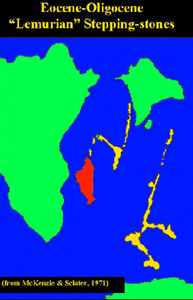 |
QUICK SEARCH
MO PROJECTS:
Africa
Asia/Pacific
Mesoamerica
North America
South America
General Taxonomy
Photo Essays
Training in Latin
America
MO RESEARCH:
Wm. L. Brown Center
Bryology
GIS
Graduate Studies
Research Experiences
for Undergraduates
Imaging Lab
Library
MBG Press
Publications
Climate Change
Catalog Fossil Plants
MO DATABASES:
W³MOST
Image Index
Rare Books
Angiosperm
Phylogeny
Res Botanica
All Databases
INFORMATION:
What's New?
People at MO
Visitor's Guide
Herbarium
Jobs & Fellowships
Symposium
Research Links
Site Map
Search
Malagasy/Indo-australo-malesian Phytogeographic ConnectionsLong Distance Dispersal | Conclusion | References EOCENE / OLIGOCENE "LEMURIAN STEPPING-STONES"
Calling attention to a distributional pattern that included (Africa)/Madagascar, the Seychelles, (India)/Sri Lanka and W. Malesia, van Steenis (1962), in his now infamous paper on the land-bridge theory, asserted that "there must have been an isthmian connection between Madagascar and Ceylon over the Seychelles-Comores bank" operating during the middle to upper Cretaceous, which he named "Lemuria". Modern understanding of the geological history of the Indian Ocean refutes both the timing and existence of such a direct land route (Mckenzie & Sclater 1973), but the distributional pattern nevertheless still stands, and for some taxa also includes China, Japan, and E. Malesia. Such a pattern often involves closely-related species in, and around the periphery of, the Indian Ocean and Africa. As India assumed its current position from the early Eocene onward, global sea levels were dropping, with a marked regression at the Rupellian/Chattian boundary during the Oligocene, i.e., ca. 30 MYA (Haq et al. 1988).

Figure 2. Schematic representation of migration pathways active
during Eocene/Oligocene after India has attained close proximity
to Asia, through to post-collision (and continuing to present), a
period during which sea-levels were dropping. Mesic Laurasian
and W. Malesian elements enter Madagascar/Africa via India and
"Lemurian Stepping-stones" in the W. Indian Ocean (emergent
portions of the Chagos/Laccadive Plateau and Mascarene Plateau
including the Seychelles). Xeric elements are exchanged between
N.E. Africa/Arabian Peninsula and Laurasia/India and may disperse
to dry western Madagascar. Thickness of arrow represents
probability of dispersal. As such a dispersal track coincides with the "Lemuria" land-bridge of van Steenis, I propose that it be named the "Lemurian Stepping-stones". Xeric affinities between Madagascar and India (e.g., Commiphora (Burseraceae), Delonix (Fabaceae), Moringa (Moringaceae) are best explained by overland migration through N.E. Africa/Arabian Peninsula, and do not provide additional support for the "Lemuria" land-bridge" as Wild (1965) suggested. Although the stepping-stone pathway may only have begun operating during the Eocene, there is no reason to believe that it has not remained active to the present day (Madagascar to Seychelles - 1,000 km; Seychelles to India - 2,600 km), or that migration has not also occurred in an eastward direction (e.g., Brexia (Brexiaceae), Grisollea (Icacinaceae)).
|
© 1995-2025 Missouri Botanical Garden, All Rights Reserved
4344 Shaw Blvd.
St. Louis, MO 63110
(314) 577-5100
Technical Support
